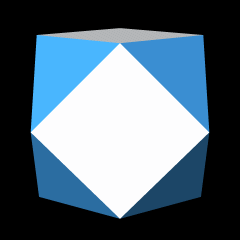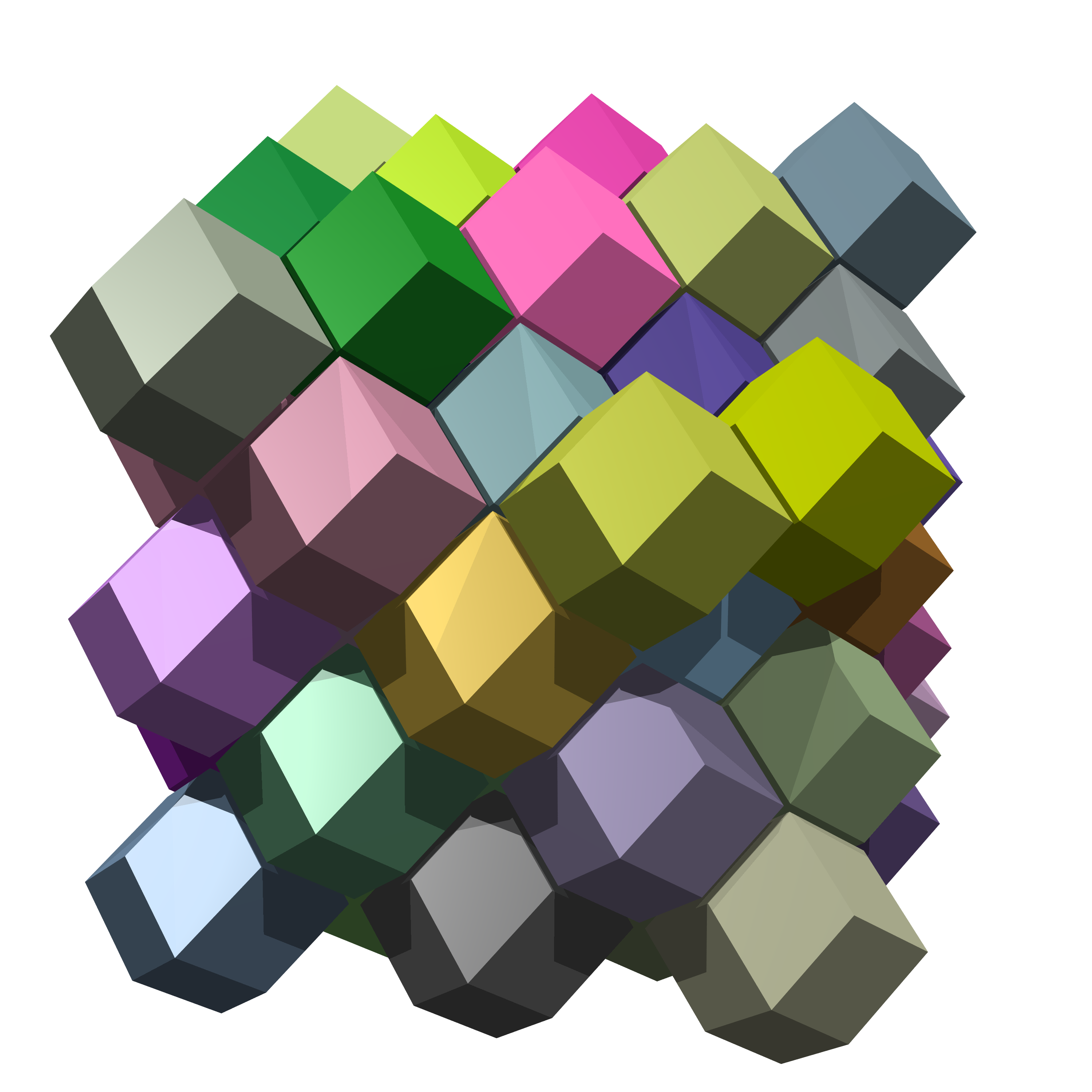|
Tetrahedral-octahedral Honeycomb
The tetrahedral-octahedral honeycomb, alternated cubic honeycomb is a quasiregular space-filling tessellation (or honeycomb) in Euclidean 3-space. It is composed of alternating regular octahedra and tetrahedra in a ratio of 1:2. Other names include half cubic honeycomb, half cubic cellulation, or tetragonal disphenoidal cellulation. John Horton Conway calls this honeycomb a tetroctahedrille, and its dual a dodecahedrille. R. Buckminster Fuller combines the two words octahedron and tetrahedron into octet truss, a rhombohedron consisting of one octahedron (or two square pyramids) and two opposite tetrahedra. It is vertex-transitive with 8 tetrahedra and 6 octahedra around each vertex. It is edge-transitive with 2 tetrahedra and 2 octahedra alternating on each edge. It is part of an infinite family of uniform honeycombs called alternated hypercubic honeycombs, formed as an alternation of a hypercubic honeycomb and being composed of demihypercube and cross-polytope facets. ... [...More Info...] [...Related Items...] OR: [Wikipedia] [Google] [Baidu] |
Cuboctahedron
A cuboctahedron is a polyhedron with 8 triangular faces and 6 square faces. A cuboctahedron has 12 identical vertex (geometry), vertices, with 2 triangles and 2 squares meeting at each, and 24 identical edge (geometry), edges, each separating a triangle from a square. As such, it is a quasiregular polyhedron, i.e., an Archimedean solid that is not only vertex-transitive but also edge-transitive. It is Cuboctahedron#Radial equilateral symmetry, radially equilateral. Its dual polyhedron is the rhombic dodecahedron. Construction The cuboctahedron can be constructed in many ways: * Its construction can be started by attaching two regular triangular cupolas base-to-base. This is similar to one of the Johnson solids, triangular orthobicupola. The difference is that the triangular orthobicupola is constructed with one of the cupolas twisted so that similar polygonal faces are adjacent, whereas the cuboctahedron is not. As a result, the cuboctahedron may also called the ''triangular gyro ... [...More Info...] [...Related Items...] OR: [Wikipedia] [Google] [Baidu] |
Euclidean 3-space
In geometry, a three-dimensional space (3D space, 3-space or, rarely, tri-dimensional space) is a mathematical space in which three values (''coordinates'') are required to determine the position of a point. Most commonly, it is the three-dimensional Euclidean space, that is, the Euclidean space of dimension three, which models physical space. More general three-dimensional spaces are called ''3-manifolds''. The term may also refer colloquially to a subset of space, a ''three-dimensional region'' (or 3D domain), a ''solid figure''. Technically, a tuple of numbers can be understood as the Cartesian coordinates of a location in a -dimensional Euclidean space. The set of these -tuples is commonly denoted \R^n, and can be identified to the pair formed by a -dimensional Euclidean space and a Cartesian coordinate system. When , this space is called the three-dimensional Euclidean space (or simply "Euclidean space" when the context is clear). In classical physics, it serves as a m ... [...More Info...] [...Related Items...] OR: [Wikipedia] [Google] [Baidu] |
Honeycomb (geometry)
In geometry, a honeycomb is a ''space filling'' or ''close packing'' of polyhedron, polyhedral or higher-dimensional ''cells'', so that there are no gaps. It is an example of the more general mathematical ''tiling'' or ''tessellation'' in any number of dimensions. Its dimension can be clarified as ''n''-honeycomb for a honeycomb of ''n''-dimensional space. Honeycombs are usually constructed in ordinary Euclidean geometry, Euclidean ("flat") space. They may also be constructed in non-Euclidean geometry, non-Euclidean spaces, such as #Hyperbolic honeycombs, hyperbolic honeycombs. Any finite uniform polytope can be projected to its circumsphere to form a uniform honeycomb in spherical space. Classification There are infinitely many honeycombs, which have only been partially classified. The more regular ones have attracted the most interest, while a rich and varied assortment of others continue to be discovered. The simplest honeycombs to build are formed from stacked layers or ... [...More Info...] [...Related Items...] OR: [Wikipedia] [Google] [Baidu] |
Tessellation
A tessellation or tiling is the covering of a surface, often a plane, using one or more geometric shapes, called ''tiles'', with no overlaps and no gaps. In mathematics, tessellation can be generalized to higher dimensions and a variety of geometries. A periodic tiling has a repeating pattern. Some special kinds include '' regular tilings'' with regular polygonal tiles all of the same shape, and '' semiregular tilings'' with regular tiles of more than one shape and with every corner identically arranged. The patterns formed by periodic tilings can be categorized into 17 wallpaper groups. A tiling that lacks a repeating pattern is called "non-periodic". An '' aperiodic tiling'' uses a small set of tile shapes that cannot form a repeating pattern (an aperiodic set of prototiles). A '' tessellation of space'', also known as a space filling or honeycomb, can be defined in the geometry of higher dimensions. A real physical tessellation is a tiling made of materials such as ... [...More Info...] [...Related Items...] OR: [Wikipedia] [Google] [Baidu] |
Quasiregular Honeycomb
In geometry, a quasiregular polyhedron is a uniform polyhedron that has exactly two kinds of regular faces, which alternate around each vertex. They are vertex-transitive and edge-transitive, hence a step closer to regular polyhedra than the semiregular, which are merely vertex-transitive. Their dual figures are face-transitive and edge-transitive; they have exactly two kinds of regular vertex figures, which alternate around each face. They are sometimes also considered quasiregular. There are only two convex quasiregular polyhedra: the cuboctahedron and the icosidodecahedron. Their names, given by Kepler, come from recognizing that their faces are all the faces (turned differently) of the dual-pair cube and octahedron, in the first case, and of the dual-pair icosahedron and dodecahedron, in the second case. These forms representing a pair of a regular figure and its dual can be given a vertical Schläfli symbol \begin p \\ q \end or ''r'', to represent that their faces are ... [...More Info...] [...Related Items...] OR: [Wikipedia] [Google] [Baidu] |
Edge-transitive
In geometry, a polytope (for example, a polygon or a polyhedron) or a Tessellation, tiling is isotoxal () or edge-transitive if its Symmetry, symmetries act Transitive group action, transitively on its Edge (geometry), edges. Informally, this means that there is only one type of edge to the object: given two edges, there is a Translation (geometry), translation, Rotation (mathematics), rotation, and/or Reflection (mathematics), reflection that will move one edge to the other while leaving the region occupied by the object unchanged. Isotoxal polygons An isotoxal polygon is an even-sided i.e. equilateral polygon, but not all equilateral polygons are isotoxal. The Duality (mathematics)#Dimension-reversing dualities, duals of isotoxal polygons are isogonal polygons. Isotoxal 4n-gons are Central symmetry, centrally symmetric, thus are also zonogons. In general, a (non-regular) isotoxal 2n-gon has \mathrm_n, (^*nn) dihedral symmetry. For example, a (non-square) rhombus is an isotoxa ... [...More Info...] [...Related Items...] OR: [Wikipedia] [Google] [Baidu] |
Vertex-transitive
In geometry, a polytope (e.g. a polygon or polyhedron) or a tiling is isogonal or vertex-transitive if all its vertices are equivalent under the symmetries of the figure. This implies that each vertex is surrounded by the same kinds of face in the same or reverse order, and with the same angles between corresponding faces. Technically, one says that for any two vertices there exists a symmetry of the polytope mapping the first isometrically onto the second. Other ways of saying this are that the group of automorphisms of the polytope '' acts transitively'' on its vertices, or that the vertices lie within a single '' symmetry orbit''. All vertices of a finite -dimensional isogonal figure exist on an -sphere. The term isogonal has long been used for polyhedra. Vertex-transitive is a synonym borrowed from modern ideas such as symmetry groups and graph theory. The pseudorhombicuboctahedronwhich is ''not'' isogonaldemonstrates that simply asserting that "all vertices look ... [...More Info...] [...Related Items...] OR: [Wikipedia] [Google] [Baidu] |
Dodecahedrille Cell
The rhombic dodecahedral honeycomb (also dodecahedrille) is a space-filling tessellation (or honeycomb) in Euclidean 3-space. It is the Voronoi diagram of the face-centered cubic sphere-packing, which has the densest possible packing of equal spheres in ordinary space (see Kepler conjecture). Geometry It consists of copies of a single cell, the rhombic dodecahedron. All faces are rhombi, with diagonals in the ratio 1:. Three cells meet at each edge. The honeycomb is thus cell-transitive, face-transitive, and edge-transitive; but it is not vertex-transitive, as it has two kinds of vertex. Each vertex with the obtuse rhombic face angles is shared by 4 cells; each vertex with the acute rhombic face angles is shared by 6 cells. The rhombic dodecahedron can be twisted on one of its hexagonal cross-sections to form a trapezo-rhombic dodecahedron, which is the cell of a somewhat similar tessellation, the Voronoi diagram of hexagonal close-packing. Colorings The tiling's cells ... [...More Info...] [...Related Items...] OR: [Wikipedia] [Google] [Baidu] |
Dual Polytope
In geometry, every polyhedron is associated with a second dual structure, where the vertices of one correspond to the faces of the other, and the edges between pairs of vertices of one correspond to the edges between pairs of faces of the other. Such dual figures remain combinatorial or abstract polyhedra, but not all can also be constructed as geometric polyhedra. Starting with any given polyhedron, the dual of its dual is the original polyhedron. Duality preserves the symmetries of a polyhedron. Therefore, for many classes of polyhedra defined by their symmetries, the duals belong to a corresponding symmetry class. For example, the regular polyhedrathe (convex) Platonic solids and (star) Kepler–Poinsot polyhedraform dual pairs, where the regular tetrahedron is self-dual. The dual of an isogonal polyhedron (one in which any two vertices are equivalent under symmetries of the polyhedron) is an isohedral polyhedron (one in which any two faces are equivalent .., and vice v ... [...More Info...] [...Related Items...] OR: [Wikipedia] [Google] [Baidu] |
Coxeter Group
In mathematics, a Coxeter group, named after H. S. M. Coxeter, is an abstract group that admits a formal description in terms of reflections (or kaleidoscopic mirrors). Indeed, the finite Coxeter groups are precisely the finite Euclidean reflection groups; for example, the symmetry group of each regular polyhedron is a finite Coxeter group. However, not all Coxeter groups are finite, and not all can be described in terms of symmetries and Euclidean reflections. Coxeter groups were introduced in 1934 as abstractions of reflection groups, and finite Coxeter groups were classified in 1935. Coxeter groups find applications in many areas of mathematics. Examples of finite Coxeter groups include the symmetry groups of regular polytopes, and the Weyl groups of simple Lie algebras. Examples of infinite Coxeter groups include the triangle groups corresponding to regular tessellations of the Euclidean plane and the hyperbolic plane, and the Weyl groups of infinite-dimensional ... [...More Info...] [...Related Items...] OR: [Wikipedia] [Google] [Baidu] |






